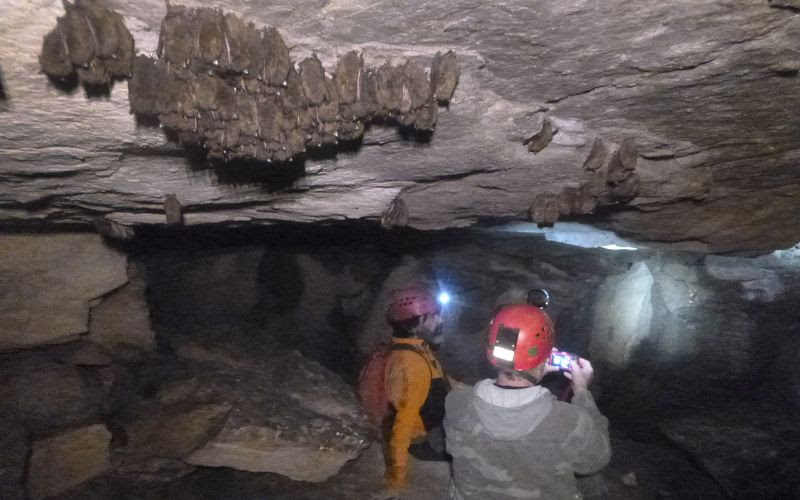
White-nose syndrome, as seen on the muzzle and wings of this little brown bat, is an insidious disease killing thousands of bats. Photo by Rick Reynolds/DWR
There hasn’t been much good news for bat populations in Virginia since the discovery of white-nose syndrome in 2009, as the bat populations of certain species such as little brown, Indiana, and tri-colored bats in Virginia have dropped by more than 90 percent.
And while the Endangered Species Act (ESA) can’t protect bats from white-nose syndrome, ESA protections have helped bat populations in other ways that has enabled them to continue being part of Virginia’s diverse array of wildlife, even as white-nose has ravaged their numbers.
“The ESA provides a higher profile for those species, so more emphasis is placed on trying to address the issues, such as white-nose, that are impacting the species,” said Rick Reynolds, a non-game biologist with the Virginia Department of Wildlife Resources (DWR). “There’s a lot of effort out there, and scientists are making progress on some methods to help bats get through the hibernation period, when white-nose has its greatest impact. They are looking at different types of treatments, not just on the bat itself, but also on the habitat. Additional resources are be directed toward helping the summer colonies, with management and protection at those sites.”
White-nose syndrome (WNS) is caused by the fungus Pseudogymnoascus destructans, or Pd for short. Pd grows best at temperatures between 40-50 degrees and high humidity levels—the same temperature gradient and humidity levels present in the caves in which most of Virginia’s bats prefer to hibernate. The fungus grows into the exposed dermis (skin) of the bat’s tail membrane, wings, ears, and muzzle. The fungus both irritates the bats and disrupts their water balance, dehydrating them. This causes them to wake up twice as often during hibernation as they normally would. The additional activity depletes the bats’ fat stores as they use additional precious energy flying to find insects to eat. The effects can be fatal.
Pre-white-nose, initial listing of bat species on the federal Endangered and Threatened Species List came from population declines due to human disturbance at cave hibernacula (caves where they hibernate) during the hibernation period (winter). Protections and strategies put in place by the ESA helped mitigate those threats.
“The ESA basically gave us the funding and the opportunity to identify the primary hibernacula for several of the endangered species and then allowed us the opportunity to protect those sites, either through land acquisition or landowner cooperative agreements,” said Reynolds. “We’ve installed bat-friendly gates on the hibernacula, to minimize disturbance at those sites during hibernation period. Twenty or 30 years ago, disturbance during hibernation was the main issue with respect to bats and their decline. We’ve got a pretty good handle on the threatened and endangered bat species with respect to winter hibernacula and protection of those sites.”
The habitat and protection work done under the ESA was valuable for bats as white-nose began in the ‘90s. Biologists in other states are working to find treatments for white-nose in both bats and their habitats, and Virginia biologists are keeping informed about their work through the White-Nose Syndrome Response Team. This Response Team has developed a national plan and working groups. Virginia’s efforts have been focused on surveillance, conservation and recovery, and outreach, as well as supporting researchers studying treatments for the disease. Identifying the locations of surviving populations is key to being able to protect and manage them.
“I think what we’re beginning to see is population stabilization with some of the species that are being impacted by white-nose,” said Reynolds. “They are kind of taking care of themselves, if you will, by making some behavioral modifications. In New York, researchers found that little brown bats going into hibernation are fatter post white-nose than pre-white-nose, in some cases by almost a whole gram. I think these bats are learning that the fat bat fares better over the winter. Things that we have noticed in Virginia and other states is that it seems like the bats push the limitations of going into hibernation—waiting later to enter the caves and leaving earlier than they did pre-white-nose.” Because the fungus needs that cold, moist climate of the cave hibernacula to survive, the bats are “limiting the time that they spend in the environment that makes them sick,” said Reynolds.
By Molly Kirk, Department of Wildlife Resources



